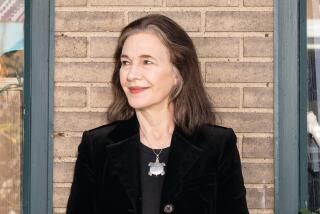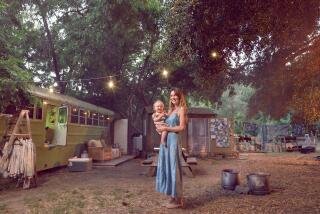Realizing the Dream
NEW YORK — As a child, Elaina Richardson would gaze out from a 17th-floor apartment at the lights of Glasgow. Each beam told her a story of the people and the glamorous life she felt sure was out there.
Now, 30 years later, the editor of Elle magazine looks out over the diamond brilliance of Manhattan’s night sky from the window of her 44th-floor office and thinks of the lights of her Scottish girlhood. In those days she was Elaina Henderson, a youngster growing up in the middle of Castlemilk, one of Europe’s toughest and most deprived housing projects.
Today, Glasgow’s River Clyde has been swapped for the Hudson and the housing project for the historic Belnord building on Manhattan’s Upper West Side. Instead of singing at gatherings with neighbors, she hosts parties for the likes of Gabriel Byrne and Liam Neeson. She rides to work in a limousine and shares offices and dinners with John F. Kennedy Jr.
At 36, Richardson has achieved the kind of success that goes beyond anything she might have dreamed of as a child.
Richardson remembers the day in 1966 when she moved to the housing project. Her father had been sick in the hospital for a year, and the relocation out of the tenements of Govan was thrilling for Elaina and her older sister, Lynda. Castlemilk--the name made it sound like an idyllic fantasy.
At first, the spanking-new project seemed full of promise to the families who lived in Glasgow’s notorious slums. No longer would they have to use communal toilets and go down the street to the wash house.
Castlemilk was really a small town, with about 40,000 residents (around 18,000 now) housed in nine stark concrete high-rises and rows of tenement-like structures spread over 600 acres six miles from the city.
Before long the place went shabby, stairways became covered in graffiti and smelled of urine, apartments were left burned out, unruly kids roamed the streets and drug-related crime crept up.
But the Hendersons were relatively well off. He was back to work as a printer, and his wife was working part time in a law office.
Richardson was 5 when she moved to Castlemilk; she left at 17. Her parents still live there. When she returns, she sees a place trying to regenerate--but a hopelessness still hangs around the street corners with the drunks and drug dealers.
There is only a slight trace of a Scottish accent when Richardson tries to vocalize her feelings for Castlemilk.
“I remember as a teenager flicking back and forth between a kind of romanticism about it and a complete hatred of it,” she says.
As a girl lolling around on the hills near the project, Richardson would fantasize about getting away.
“Because of where I came from, I was always made to feel embarrassed in Glasgow,” she says. “That’s why I decided that for sure I didn’t want to stay there.”
Her gently pushing parents helped her overcome the prejudice.
“I did study hard, but I was also somebody who hung about smoking on street corners,” she says. While her friends stayed on the street corner, Richardson moved on.
She went to university in Edinburgh, then earned a graduate degree in 18th century English literature at Oxford. There she met Kevin Richardson, son of Hamilton “Ham” Richardson, a top-ranked U.S. tennis player of the 1950s. They married in 1988 and have a daughter, Caitlin, now 6.
“I don’t think I would have moved to America minus Kevin,” Richardson says.
“When he heard about me doing this interview, my husband said: ‘Oh, no, not “Elaina’s Ashes,” ’ “ says Richardson, referring to “Angela’s Ashes,” Frank McCourt’s best-selling account of life growing up in the grinding poverty of Limerick, Ireland. It was Kevin and his family--his stepmother is Midge Richardson, former editor of Seventeen magazine--who gave Richardson her sense that there was no limit to her potential.
“Midge asked me, ‘Given your druthers, what would you like to do?’ And I remember trying to impress the family by saying I would like to be the editor of a magazine, and she said, ‘Well, you’ll have to do this, this and this.’ She didn’t say it couldn’t happen.”
*
With a few letters of recommendation from her future mother-in-law, Richardson began to knock at journalism’s door. Her first stop was Washington, D.C., where she did some freelancing. In 1987, the couple moved to New York, where she worked for the New York Post, then the fashion magazine Mirabella and then, in 1993, Elle. Quite confidently, Richardson says she believes Elle has been much livelier since her arrival. Certainly, by contrast to other magazines in the same market, circulation is up.
Richardson tries to pinpoint what it has been about her upbringing that got her to where she is.
She tries to explain it through a dream that she frequently has in which she returns to her high school to give a motivational speech to the students.
“Always in the dream I am on the stage at my old school. . . . I am trying to explain to the kids that if they are ever going to get anywhere, they need to have an education and a good sense of who they are. I try to tell them I know how hard it is,” she says. “I think I am trying to work out [for] myself why it was me who got away. I guess I am telling them I learned pretty early you should always speak up. The thing is, in America, people will listen.”
More to Read
Sign up for Essential California
The most important California stories and recommendations in your inbox every morning.
You may occasionally receive promotional content from the Los Angeles Times.










